oracle 1z0-149 practice test
Oracle Database Program with PL/SQL
Question 1
Which two PL/SQL elements can be deprecated using the DEPRECATE pragma? (Choose two.)
- A. PACKAGES
- B. VARIABLES
- C. ANONYMOUS BLOCK
- D. TRIGGER BODY
- E. DATABASE LINKS
Answer:
A, E
Question 2
Which three are true about functions and procedures? (Choose three.)
- A. The ACCESSIBLE BY clause can be used only for procedures.
- B. In a function, every execution path must lead to a RETURN statement.
- C. Both can have only constants as actual parameters for IN mode parameters.
- D. Both can be invoked from within SQL statements.
- E. In a procedure the RETURN statement cannot specify an expression.
- F. In a function every RETURN statement must specify an expression.
Answer:
B, E, F
Question 3
Which two are true about Conditional Compilation in PL/SQL using $IF, $ELSE, $END, and $ERROR?
(Choose two.)
- A. PL/SQL code can be compiled and executed based on different versions of the operating system.
- B. PL/SQL code can be compiled and executed based on different versions of Oracle.
- C. It is newer syntax that works the same way as 'IF , ELSEIF , ELSE, and END IF'.
- D. Conditional compilation is disabled by default.
- E. The PL/SQL compiler can conditionally include selected parts of a program.
Answer:
B, E
Question 4
Which three are true about the NOCOPY hint, the PARALLEL ENABLE hint, and the DETERMINISTIC
clause? (Choose three.)
- A. The PARALLEL_ENABLE clause can be used only in the CREATE FUNCTION statement.
- B. The NOCOPY hint asks the compiler to pass the actual parameters by reference.
- C. A deterministic function's results always depend on the state of session variables.
- D. The NOCOPY hint asks the compiler to pass the actual parameters by value.
- E. A function is deterministic if it always returns the same result for a specific combination of input values.
- F. The PARALLEL_ENABLE clause can be specified for a nested function.
- G. A function defined with the PARALLEL_ENABLE clause may be executed in parallel in a SELECT statement or a subquery in a DML statement.
Answer:
B, E, G
Question 5
Which two are true about INDEX-BY tables? (Choose two.)
- A. The index can be integer or string.
- B. The index can be integer only.
- C. INDEX-BY table types can be created in PL/SQL blocks only.
- D. INDEX-BY table types can be created both with the CREATE TYPE statement and in PL/SQL blocks.
- E. INDEX-BY table types can be created with the CREATE TYPE statement.
Answer:
A, C
Question 6
Which three are true about anonymous blocks and subprograms? (Choose three.)
- A. Named subprograms cannot be called from other packages.
- B. PROCEDURE subprograms can accept parameters.
- C. A FUNCTION subprogram must return one or more values.
- D. Anonymous blocks cannot use packaged variables.
- E. Named subprograms are stored in the database server.
- F. Anonymous blocks must always start with the Declare keyword.
- G. FUNCTION subprograms must be called and passed through one or more parameters.
Answer:
B, C, E
Question 7
Which two statements are true about using the OR REPLACE clause when creating named
subprograms? (Choose two.)
- A. Function based indexes remain usable when replacing the function on which the index depends.
- B. Object privileges to execute a replaced function must be regranted to those users who had the privilege.
- C. This clause can be used only for procedures and functions.
- D. A function definition can be modified without dropping and re-creating it.
- E. Object privileges to execute a replaced function are retained by those users who had the privileges.
Answer:
D, E
Question 8
Examine the SH.PRODUCTS table:
A row exists in SH.PRODUCTS with PDT_ID = 1.
Now, examine this code and output executed by SH:
Now, examine this block of code:
Which error message(s) does it display on execution by user SH?
- A. Error in inner block
- B. Error in inner block Error in outer block
- C. Error in inner block Error in calling block
- D. Error in inner block Error in outer block Error in calling block
Answer:
A
Question 9
Which two blocks of code display a numerical zero? (Choose two.)
A.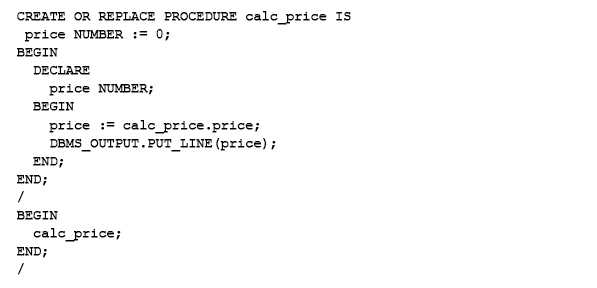
B.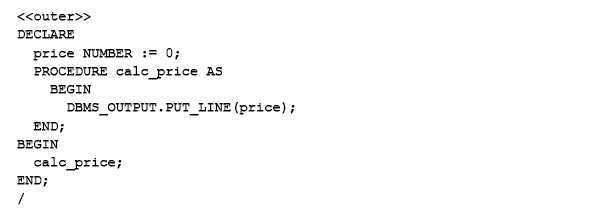
C.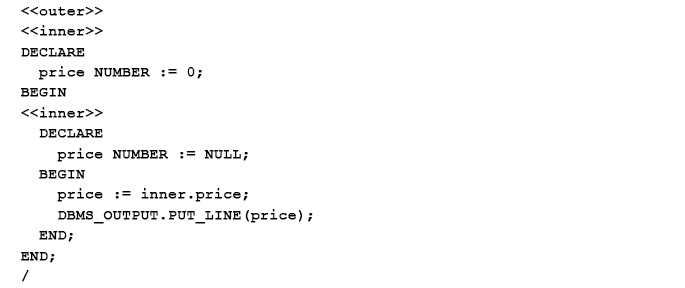
D.
Answer:
A, B
Question 10
Which three are valid PL/SQL variable names? (Choose three.)
- A. printer_name#
- B. 1to7number
- C. yesterday's_date
- D. leap$year
- E. Number_of_days_between_March_and_April
- F. #printer_name
- G. v_fname
Answer:
A, D, G
Question 11
Which two are true about collections and RECORD types? (Choose two.)
- A. A variable of RECORD type can contain fields of another RECORD type or any collection type.
- B. Only associative arrays and nested tables can have elements of RECORD type.
- C. All collections and RECORD types can be defined in PL/SQL blocks, packages, or at the schema level.
- D. Collections and RECORD types are always dense.
- E. All collections and RECORD types can be stored in table columns.
- F. VARRAYS, nested tables and each field in %ROWTYPE type variables have a default value of null.
Answer:
B, F
Question 12
Examine this table in the SH schema:
User SH executes this code: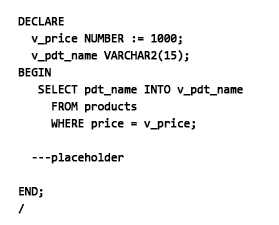
The program must terminate with a user-defined message and no rows displayed if more than one
product's price is 1000.
With which option must “---placeholder” be replaced?
A.
B.
C.
D.
E.
Answer:
A
Question 13
Examine this row of data from the EMPLOYEES table:
Now, examine this block of code which executes successfully: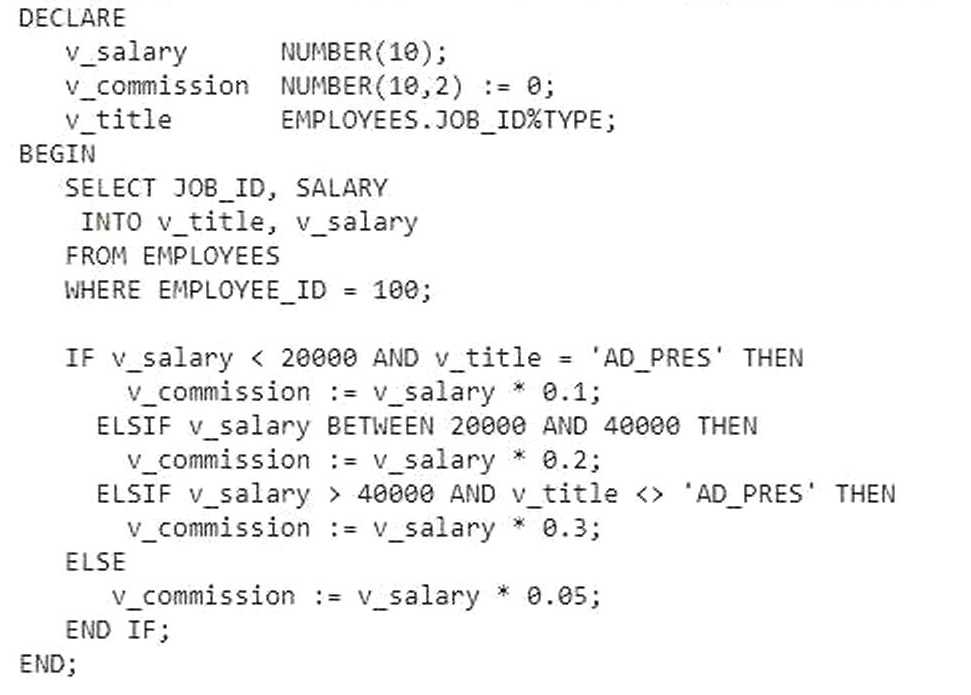
What is the value of v_commission?
- A. 5000
- B. 15000
- C. 2500
- D. 10000
Answer:
C
Question 14
Examine this table in the SH schema:
Now, examine this code:
Which two changes are required to ensure that PDT_REPORT executes successfully? (Choose two.)
- A. In line 1, change IN OUT mode to IN mode.
- B. In line 2, change IN OUT mode to IN mode.
- C. In line 3, replace CUR_PRICE with P_PDT_PRICE in the query condition.
- D. In line 1, add the default parameter DEFAULT 2000.
- E. In line 6, replace P_PDT_PRICE parameter name with CUR_PRICE.
- F. In line 2, add the default parameter DEFAULT 2000.
Answer:
B, D
Question 15
User ORA41 executes these statements successfully:
Now, examine this statement which is executed successfully by user ORA61 after a successful login:
EXECUTE ora41.update_emp_proc(100,25000);
Which two are true? (Choose two.)
- A. The salary will be changed for employee 100 in the EMPLOYEES table owned by ORA41.
- B. No update happens even though the procedure executes successfully.
- C. The salary will be changed for employee 100 in the EMPLOYEES table owned by ORA61.
- D. The UPDATE privilege on ORA41.EMPLOYEES is not inherited by ORA61 through the procedure.
- E. ORA61 will have been granted the UPDATE privilege explicitly on ORA41.EMPLOYEES before executing the statement.
Answer:
C, D